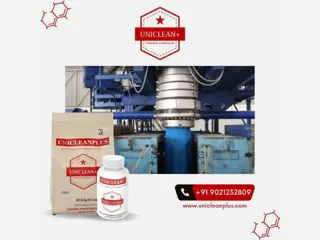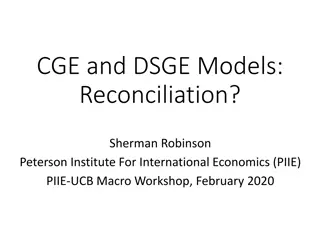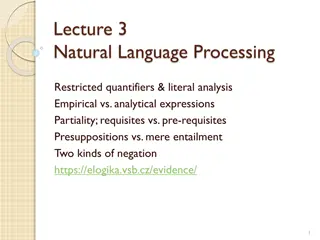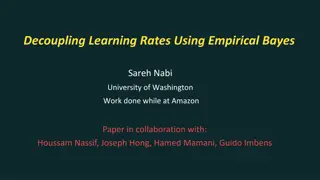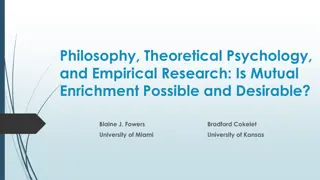Multi-Optimization of Empirical Models for Material Extrusion Process
Increased demand in the manufacturing industry has led to a focus on Additive Manufacturing (AM) tools and techniques. This study explores the optimization of material extrusion process parameters to enhance performance measures, addressing challenges such as print speed, accuracy, and mechanical properties. Key drivers include creating functional parts with complex geometry, reducing lead times and costs. By identifying and evaluating key process parameters, this research aims to enhance the efficiency and quality of AM processes.
Download Presentation

Please find below an Image/Link to download the presentation.
The content on the website is provided AS IS for your information and personal use only. It may not be sold, licensed, or shared on other websites without obtaining consent from the author.If you encounter any issues during the download, it is possible that the publisher has removed the file from their server.
You are allowed to download the files provided on this website for personal or commercial use, subject to the condition that they are used lawfully. All files are the property of their respective owners.
The content on the website is provided AS IS for your information and personal use only. It may not be sold, licensed, or shared on other websites without obtaining consent from the author.
E N D
Presentation Transcript
MULTI-OPTIMIZATION OF EMPIRICAL MODELS FOR THE MATERIAL EXTRUSION PROCESS SCHURAVI N. MALLIAN1*, BOPPANA V. CHOWDARY2 Schuravi Mallian Pyramid Engineering and Fabrication Services Limited Boppana V. Chowdary University of the West Indies IConETech-2020, Faculty of Engineering, The UWI, St. Augustine, Trinidad and Tobago
INTRODUCTION Increased pressure on manufacturing industry. Companies compete to deliver products on a continuous basis to fulfil the demands of an ever evolving market. Additive Manufacturing (AM) tools and techniques. Standardization of parts produced by AM Identifying and evaluating key process parameters that impact the performance measures. IConETech-2020, Faculty of Engineering, The UWI, St. Augustine, Trinidad and Tobago
ADDITIVE MANUFACTURING Additive Manufacturing layer based technique IConETech-2020, Faculty of Engineering, The UWI, St. Augustine, Trinidad and Tobago
MATERIAL EXTRUSION Material Extrusion (ME) is an AM technique which forms 3D objects by stacking multiple layers of semi-molten materials vertically. ME Process IConETech-2020, Faculty of Engineering, The UWI, St. Augustine, Trinidad and Tobago
MATERIAL EXTRUSION ME Process Parameters IConETech-2020, Faculty of Engineering, The UWI, St. Augustine, Trinidad and Tobago
MATERIAL EXTRUSION Key Drivers Functional parts with complex geometry Reduction in lead times and costs Challenges Print speed, accuracy and mechanical properties Dependant upon machine parameters Focus Investigation of process parameters effects on performance measures. IConETech-2020, Faculty of Engineering, The UWI, St. Augustine, Trinidad and Tobago
MATERIALS AND METHODS Raster Angle Raster Width Part Orientation Layer Thickness Stress VS Strain 70 60 50 40 30 20 10 0 0 5 10 15 20 25 IConETech-2020, Faculty of Engineering, The UWI, St. Augustine, Trinidad and Tobago
Process parameters and levels Build Parameters Raster Angle (degrees) Level 1 Level 2 Level 3 0 45 90 Raster Width (mm) Part Orientation (degrees) Layer Thickness (mm) 0.2 0.3 0.4 0 5 10 0.1 0.2 0.3 IConETech-2020, Faculty of Engineering, The UWI, St. Augustine, Trinidad and Tobago
RESPONSE SURFACE METHODOLOGY Main Effects Plot of Responses IConETech-2020, Faculty of Engineering, The UWI, St. Augustine, Trinidad and Tobago
ARTIFICIAL NEURAL NETWORK Capable of performing complex function approximations even when only part of a dataset is given. The neural network consists of 3 main sections; input layer, hidden layer and output layer. Feed forward back propagation combined with a Bayesian Regularization training function. Network structure 4-6-6-3 IConETech-2020, Faculty of Engineering, The UWI, St. Augustine, Trinidad and Tobago
ARTIFICIAL NEURAL NETWORK ANN Regression Plot IConETech-2020, Faculty of Engineering, The UWI, St. Augustine, Trinidad and Tobago
OPTIMIZATION RESULTS Optimized Process Parameters Index ANN- GA RSM- GA x1( ) 62.4955 4 83.0210 8 x2(mm) 0.39857 7 0.37236 7 x3( ) 0.13727 7 0.01043 7 x4(mm) 0.29990 8 0.25181 5 f1(min) 42.7186 3 43.3975 5 f2(g) 9.32620 6 8.76720 2 f3 (MPa) 64.0815 74.5654 Validation of Optimized Process Parameters Index ANN- GA RSM- GA x1( ) x2(mm) x3( ) x4(mm) f1(min) f2(g) f3 (MPa) 62 0.40 0 0.300 43 9.3 150.920 83 0.37 0 0.2518 55 9.0 149.478 IConETech-2020, Faculty of Engineering, The UWI, St. Augustine, Trinidad and Tobago
OPTIMIZATION RESULTS Percentage Error for Optimized ANN and RSM models Index f1(min) f2(g) f3(MPa) ANN-GA 0.00% 0.00% 57.05% RSM-GA 21.81% 2.00% 50.12% IConETech-2020, Faculty of Engineering, The UWI, St. Augustine, Trinidad and Tobago
CONCLUSION Small layer thickness when paired with high part orientation angle negatively impacts build time and material consumption, however specimens can withstand higher mechanical loads. Large raster angles improve build time and material consumption while decreasing overall strength. Increased raster widths improve build time and mechanical strength though requires more material to be deposited. Offline prediction models allows designers to ensure parts are built with the optimal parameters to reduce lead times. IConETech-2020, Faculty of Engineering, The UWI, St. Augustine, Trinidad and Tobago
FUTURE RESEARCH Use of Q-Optimal design, allowing for higher empirical or custom models. Multi-objective optimization studies on other mechanical properties such as creep, vibration, cyclic tensile fatigue and wear characteristics. IConETech-2020, Faculty of Engineering, The UWI, St. Augustine, Trinidad and Tobago
REFERENCES Sood, Anoop Kumar. 2011. "Study on parametric optimization of fused deposition modelling (FDM) process." ISO/ASTM. 2015. Standard Terminology for Additive Manufacturing - General Principles - Terminology. United States: ISO Di Angelo, Luca, and Paolo Di Stefano. 2011. "A neural network-based build time estimator for layer manufactured objects." The International Journal of Advanced Manufacturing Technology 57 (1-4):215-224. Alomari, Mohammad H, Ola Younis, and Sofyan MA Hayajneh. 2018. "A Predictive Model for Solar Photovoltaic Power Using the Levenberg-Marquardt and Bayesian Regularization Algorithms and Real-Time Weather Data." J. Adv. Comput. Sci. Appl 9:347-353 IConETech-2020, Faculty of Engineering, The UWI, St. Augustine, Trinidad and Tobago
THANK YOU! IConETech-2020, Faculty of Engineering, The UWI, St. Augustine, Trinidad and Tobago




